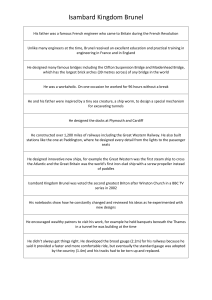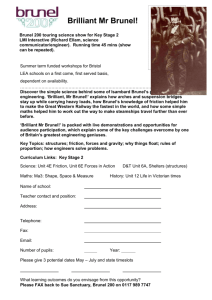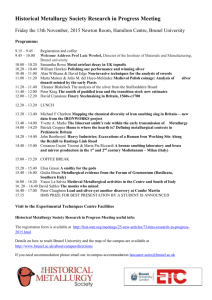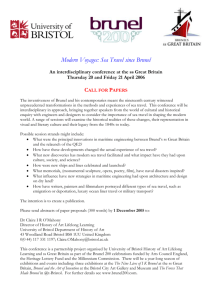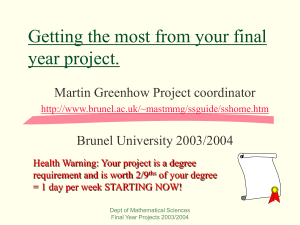Getting the most from your project.
advertisement
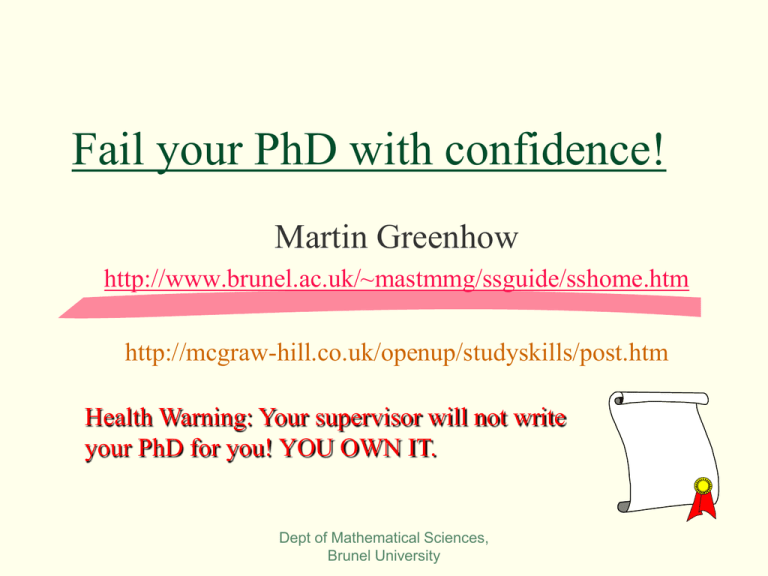
Fail your PhD with confidence! Martin Greenhow http://www.brunel.ac.uk/~mastmmg/ssguide/sshome.htm http://mcgraw-hill.co.uk/openup/studyskills/post.htm Health Warning: Your supervisor will not write your PhD for you! YOU OWN IT. Dept of Mathematical Sciences, Brunel University 7 ways of failing Not wanting a PhD Overestimating what’s needed – never getting started (frozen) Underestimating what’s needed – never getting started Having a crap supervisor (not really an excuse!) Having a good supervisor, but thinking he/she is crap Not having a (testable) ‘thesis’ Taking a job before completion (not always fatal) Dept of Mathematical Sciences, Brunel University 7 more ways of failing Getting disheartened Getting sidetracked (teaching/other interests) Changing topic/supervisor Not looking after yourself (friends, sport, interests) Under-valuing your worth Under-valuing the worth of your research Guilt (no it’s an investment in yourself) Others … ? Dept of Mathematical Sciences, Brunel University You should by end year 1: have a good idea about what your project will involve. Sounds obvious, doesn’t it?! have read the backgound, some review/original papers in the same area and related textbooks (not just Google!). have attended courses have started to make notes from these sources; keep this focussed and don’t copy out sections from books, download chunks from the Web or CDs - this is plagiarism! You will synthesise these notes into a narrative later. have written down exact references as you find them. have started a week-by-week log book. have completed a model problem and written it up. have been appraised! given a presentation to other PhD students/staff. Dept of Mathematical Sciences, Brunel University You should by start year 2: have a good understanding of the theory and methods to be used. have read most of the background material and made notes/references. Tackled YOUR main problem have made a start on any programming involved. It is not possible to write a decent program without completely understanding what you want/need to do, so ask your supervisor if anything is not clear. Then draw a flow chart or write “pseudo code” to specify how the program will work before getting bogged down in language syntax. Back-up all programs and check them using TEST CASES. have considered writing drafts as you go along to aid your thinking; in mathematics this technique is perhaps less useful, but you must keep very detailed notes and back them up with photocopies or notes on your PC (AND Brunel network). have seen your supervisor at least ? times. Dept of Mathematical Sciences, Brunel University Log book and Plans Log Book Make sure your log book is up to date and include failures as well as successes include how long it took you to do each item write down ALL ideas you have as you work (they will be useful for your Recommendations). Regular Plan Prepare a regular plans and ask your supervisor for comments, especially on your plans & REALISTIC timings for further work Dept of Mathematical Sciences, Brunel University Year 2 Giving a talk/conference paper Think about (interim) conclusions and how you will communicate your results in graphs, charts, flow charts, spray diagrams, trees etc. Prepare and practice your presentation, asking friends to time each OHP slide. Read the advice in the Study Skills Guide – yes really do this! Dept of Mathematical Sciences, Brunel University You should by middle of year 3: have finished all the actual project content. have structured the main sections and typed them up. This will take longer than you think! have acted on your supervisor’s comments on your draft chapters. have produced all the graphs and diagrams. Have career plans … de-stresses you/one less thing to think about Dept of Mathematical Sciences, Brunel University You should near the end: swap drafts with friends for comment. If your friends can’t understand what you have done in broad terms, it’s YOUR fault. write the abstract, introduction, conclusions and recommendations sections. Give these to your supervisor for comment in good time. finalise any appendices, references and program discs. act on your supervisor’s comments. put all sections together, check spelling and grammar, include headers, footers and page numbers. Dept of Mathematical Sciences, Brunel University The thesis itself Your thesis should be a “narrative text” with a coherent story line which flows logically from one section to the next in a coherent manner. See the REQUIREMENTS GUIDE; maximum length? No padding - you’ll loose your thrust/reader. The thesis itself - general points. The object of your thesis is to communicate, not impress or blind with science! Help your reader as much as possible. Use ordinary plain English, free of jargon and slang. Use diagrams, charts etc as much as possible. Stick to conventional and consistent nomenclature. Dept of Mathematical Sciences, Brunel University The thesis itself - the start. Title page - see the Requirements Guide. Acknowledgements - keep it formal! Table of contents (STRUCTURE). List of figures. Nomenclature, Definitions and Non-dimensionalisation. Abstract of about 2-4 sides. The abstract is an important guide to the reader and must describe the main area of the work and your main results. Usually written last. Dept of Mathematical Sciences, Brunel University The thesis itself - the Introduction. What the project is about. A “map” of the work undertaken. Why your work is interesting/important. Possible applications. A review of previous work. A clear statement of how you have extended the previous work. The introduction is usually written at the end of the project. Dept of Mathematical Sciences, Brunel University The thesis itself - the Method. This can be very technical, so help your reader “navigate” through the work by: clearly stating your assumptions. stressing what is most important. Move some material to appendices. using logical paragraph, section & chapter breaks. using diagrams, charts, flow charts. using equations with all terms defined; consider reminding the reader of earlier definitions. Think strategy, not detail. The method section is often written early and goes through a few drafts as the work progresses and the supervisor comments on it. Dept of Mathematical Sciences, Brunel University The thesis itself - the Results. This can be very technical, so help your reader as before. When presenting results you should: state any limitations on the generality of your results. state the accuracy of your results. describe the sensitivity of your results to changes in assumptions and parameter values. Reconsider the model assumptions and refine them if possible (a modeling cycle). Explain your results; if you can’t/won’t do this, how do you expect the reader to be able to? The results section is often written early and goes through a few drafts as the work progresses and the supervisor comments on it. Dept of Mathematical Sciences, Brunel University The thesis itself - the Conclusion. This must not contain new ideas – NOT AFTERTHOUGHTS! This must contain only statements which are supported by your work and follow naturally and logically from it. Draw some conclusions, probably taking several pages of text; if you can’t/won’t do this, why do you expect the reader to do it for you? Conclusions MUST be defensible (in a court of law) on the basis of ONLY what you have presented – no unsupported conclusions. NB The conclusion is worth a lot of attention ! Dept of Mathematical Sciences, Brunel University The thesis itself - the Recommendations. This should contain many of the ideas which will have occurred to you as you worked, and which were written down in your log book … weren’t they? This must contain ideas for future work. Imagine yourself starting a similar project … what would you want to read? Be as specific as possible about: new applications of the present theories/techniques. application in areas with similar mathematical/programming structures. Extensions which avoid the limitations/weaknesses of your work. Be honest - this is a sign that you know what you are doing and will be rewarded rather that penalised! NB The Recommendations are worth a lot of attention ! Dept of Mathematical Sciences, Brunel University The thesis itself - the Appendices. Program listings - on a disc to help future students. Data printouts - again on disc. List of software used. Logbook? Instructions for reading data and/or running any programs on the disc. Remember that the External Examiner may well want to do this, so be specific and include everything that is needed unless this infringes copyright laws. Proofs and material which underpins, but is not part of, the main narrative. Include material here which will help future PhD students. Dept of Mathematical Sciences, Brunel University The thesis itself - the References. Books. Greenhow M. (1982)“My life as a dog” Oxford Univ. Press 4th ed. Journals. Greenhow M. (1937) “The mathematics of guinea pig sexing” J. Math. Biol., 8, part 4, pp 1-59. Electronic sources: WWW - state exact URLs and date when accessed. Graphics from web (or similar) needs to be referenced. Remember: NO DOWNLOADING OF CHUNKS! NB Read the Study Skills Guide – see the examples on plagarism. Dept of Mathematical Sciences, Brunel University Why talk about all this? Note that students often get referred because of poor presentation and/or inadequate abstracts, introductions, conclusions and, especially, recommendations. Students generally do not fail because of crap content (assuming they have actually listened to their supervisors!) Dept of Mathematical Sciences, Brunel University When you get stuck. Can you define all your terms? What are the dimensions of terms in your equations? Can you non-dimensionalise your equations? What are the important parameters? Can you draw a flow chart for your program and check each part separately? Can you run simple test cases to compare your program results against analytical results? Write all variables to a file if your program gives unexpected results, and check them carefully. Dept of Mathematical Sciences, Brunel University When you get stuck again! Can you simplify your problem? Can you exploit any symmetry in your problem? Can you do sample calculations at e.g. x = 0, 1 etc? Can you do any sort of asymptotic analysis as x becomes small or big? Can you plot your results in a different way? Can you explain your problem to your supervisor or another student? If you can, you are half way to solving it! Dept of Mathematical Sciences, Brunel University The Viva. Enjoyable or not? All depends on you/your work, but examiners are not ‘out to get you!’ Good luck! Dept of Mathematical Sciences, Brunel University
